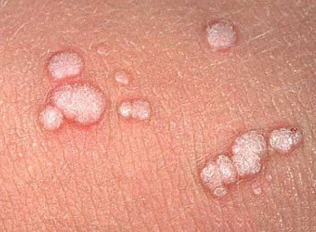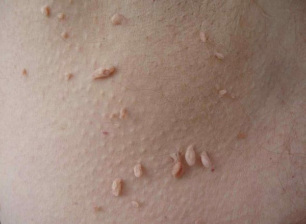Papillomas on the body arebenign formations that develop when a person is infected with papillomavirus. The growths can form on any part of the body, skin or mucous membrane, can be single or multiple.

The rapid growth and appearance of a large number of papillomas on the skin, formations on the mucous membranes is considered a serious reason for visiting a doctor. The specialist will determine the method of their removal, select an effective antiviral treatment.
What are the papillomas on the human body
Growths have several main types, differing in external characteristics, localization, and the ability to degenerate into malignant tumors.
Simple
Simple formations have a soft knobby structure. Medium to large in size. By color: dark beige, brown papillomas. Localization is extensive: face, neck, armpits, groin, chest.
Keratopapillomas
Formations with a keratinized upper layer. In most cases, they are also large on the back of the hand, between the fingers. In men, it can form on the penis, in children, legs, arms, knees are often affected. Simple dry papilloma on the foot, called plantar warts or spines. The danger of simple subcutaneous papillomas is the ability to rapidly deteriorate.
Pointed Formations
Genital formations or warts, in most cases, grow in intimate areas, affecting:

- External and internal areas of the genital organs (in men - they affect the foreskin, head of the penis; in women - the labia minora, clitoris, urethra, vestibule and walls of the vagina, cervix);
- Anality area;
- Oral cavity.
Papillomas are asymptomatic: they are painless and have no concomitant manifestations. Condylomas of this type have a papillary shape, they are flesh-colored or pinkish.
Small papillomas on the body and mucous membranes grow rapidly, their large proliferation (papillomatosis) can appear within a short time (several hours).
The danger of genital warts lies in their rapid transformation into a malignant form.
There is a risk of recurrent lesions after treatment. The situation is aggravated by the presence of sexually transmitted diseases (STDs). When planning a pregnancy, all warts must be removed. During the period of carrying a baby, pointed formations are very dangerous, since there is a possibility of transmission of the virus from mother to child (during childbirth).

Acrochords (threadlike)
Small elongated papillomas on the body are papillae on a thin stalk. They can be up to 5 mm long.
In most cases, the growths are located under the armpits, neck, eyelids and chest. Filamentous papillomas often occur in the perineal region. Acrochords appear as small yellowish outgrowths, which over time can turn into brown, black papillomas on the body. The drug method is useless for their removal, filamentous growths are removed mechanically.
Flat form
Flat formations have a smooth surface, oval or round, and are slightly darker in color than healthy skin. The average size is from one to two millimeters, they rise very slightly above the main skin.
In most cases, this type of papillomas appears in groups, localized in the upper body, covering areas of the skin: face, groin, penis, near-anal region. May occur on the cervix, rectum.
Have pronounced symptoms: inflammation, itching, pain syndrome, hyperemia (redness) of the surrounding skin.

Lewandowski-Lutz
An uncommon type of papillomas, manifested in the growth of red papillomas on the body. It most often occurs on the hands and feet. With severe exposure to sunlight, formations can rapidly degenerate into cancerous forms.
Plantar growth
Initially, the plantar micro-growths resemble a small, smooth white lump on the surface of the foot. In most cases, a thin rim protrudes along the edge of the growth.
White papillomas of this type can interfere with walking, change gait, but can disappear without external intervention. Unlike calluses, they have no skin pattern.
Juvenile
A rare type. These papillomas occur in the larynx region in babies, as a result of infection from the mother during childbirth. Their danger is that, as they grow, they impair respiratory function.
Cause of papillomas on the human body
A virus that has entered the body can remain dormant for a long time (from several months to several years). Several factors can arouse viral activity:
- Decreased body defenses. Weakening of the immune system can contribute to disruption of the gastrointestinal tract, bad habits, exacerbation of chronic diseases, prolonged use of medications, improper diet, physical and nervous overload, vitamin deficiencies;
- Hormonal disruptions. Disorders of the hormonal system can be triggered as a result of pregnancy, age-related changes, endocrinological diseases (diabetes mellitus, glandular pathology);
- Infectious inflammatory diseases of the pelvic organs (in cases of genital outgrowths).
Causes of papillomas on the body in men
In most cases, the growths appear in men at a young age (18 to 35 years). The growth of the lesions is asymptomatic, which is fraught with their degeneration into a malignant form.
The main route of transmission of the virus is through unprotected sex. A weakened immune system can serve as the causative agent of the virus: unhealthy diet, bad habits, passive lifestyle contribute to the development of the virus in the body.
In men, growths in most cases appear in the groin area, on the genitals. If you have any growths, problems with urination, or any other discomfort, you should visit your urologist.
Causes of papillomas on the body in women
The common factors in the appearance of growths are reduced immunity, hormonal disruptions. As a result of these factors, papillomas and warts appear, the causes of which in women have their own characteristics:
Congenital and acquired immunodeficiencies can cause papillomas. The risk of contracting HPV is highest during the first year after pregnancy. This is because carrying a baby leads to a change in hormonal levels, and childbirth is a strong stress for the body. Therefore, pregnancy and the postpartum period are a favorable period for the activation of the virus, which is why papillomas appear on the body.
Promiscuous sex life with frequent partner changes is the reason why papillomas appear;
- Accidental unprotected sex;
- Early onset of intimate life, which is a factor that negatively affects the state of the reproductive system, which contributes to the emergence and activation of HPV, which is why papillomas are formed on different parts of the skin and mucous membranes;
- Chronic diseases of the genital area, is one of the conditions why papillomas grow on the body;
- Sexually transmitted diseases are one of the reasons why papillomas on the body come from;
- Regular artificial termination of pregnancy.
Why do papillomas appear on the body? In order to provoke skin and mucous growths, the virus must enter the body.
In women, as in men, sexual transmission is the dominant mode of transmission. A girl can become infected not only during unprotected vaginal, oral, anal intercourse, but also during petting.
Infection method
The main methods of HPV infection:
- Unprotected intercourse. The transmission of infection is carried out through the natural secretions of the infected partner, falling on the mucous membrane of a healthy person, microtraumas resulting from external influences. Infection can occur both during traditional sexual contact, and oral, anal. Infection can occur during foreplay.
- Contact and household. Infection occurs through contact with an infected person. Most often, this is the use of common hygiene items: towels, a washing sponge. When visiting baths and saunas, walking without special shoes can provoke the appearance of plantar formations.
Why are papillomas on the body dangerous
Are papillomas on the body dangerous? The virus can be of different types: high, medium and low oncogenicity. The types of high and medium rebirth ability are especially dangerous. A specialist can determine the nature of the virus by prescribing a number of diagnostic tests.
Major complications:
- Degeneration of formations into malignant tumors (especially growths on the mucous membranes);
- Frequent trauma to the formations. As a result, the growths begin to be damaged and bleed. An infection can get into the wound, an inflammatory process can begin;
- Genital warts can cause infertility in men and women, cause problems of the genitourinary system, reduce the quality of sex life;
- HPV increases the risk of contracting STDs, growths in pregnant women can be transmitted to the baby during the passage through the birth canal
Diagnostics
Diagnostic procedures carried out to establish an accurate diagnosis, determine the method of treatment, combine:
- Expert advice:
- Dermatologist (formations on the face and neck, under the arm, on the limbs, abdomen, back);
- Urologist, gynecologist - localization of formations in the genital area, anality;
- Otolaryngologist - oropharyngeal lesions;
- Dentist - neoplasms on the tongue and oral mucosa.
- Laboratory and instrumental methods:
- PCR studies. This analysis allows to confirm the presence of viral agents in the blood, their amount, to determine the virus type (non-oncogenic, oncogenic);
- Biopsy designed for detailed examination of the body formation. This requires the collection of a microscopic area of the papilloma.
In some cases, when female genital growths are affected, additional diagnostic procedures are performed: colposcopy, oncocytology, histology, colposcopy.
How to treat skin papillomas
Effectively treating growths, stopping the growth of papillomas, both at the initial stage and with advanced development, drug therapy will help. The drugs are used to strengthen the immune forces, suppress the virus: antiviral, anti-inflammatory drugs, immunomodulators.
Lumps can be treated with topical drugs:
- Salicylic ointment with pronounced antimicrobial, anti-inflammatory, restorative properties;
- Antiviral Oxolinic Ointment;
- Celandine burning solution;
- antimicrobial ointment
Folk remedies
It is possible to destroy formations only on the skin; it is contraindicated to get rid of the growths of mucous membranes. Removal and treatment of papilloma on the skin with folk remedies is possible using recipes:
- Lubrication of affected areas with castor oil;
- Rubbing with aloe leaf can heal the growths. The sheet is cut into 2 halves, the glandular part is wiped off the formation. The procedure is performed within a week;
- Lubrication of micro-growth with garlic juice. The slices are cleaned, cut, the build-up is lubricated with the inner side. Before the procedure, nearby tissues should be treated with petroleum jelly or greasy cream to avoid burns;
- Cauterization with iodine. One of the most effective remedies than to remove papillomas on the body quickly. Burning of small and medium outgrowths is most effective. It is not recommended to cauterize large formations with iodine, since the solution cannot completely destroy the tissues of a large formation. It is impossible to exclude the degeneration of the formation damaged by iodine into a malignant tumor.
Hardware destruction
- Laser removal. The method allows you to quickly remove the papilloma, regardless of its location. The method is an effective way to remove papillomas on the body painlessly and safely. The laser evaporates the affected tissues layer by layer and simultaneously cauterizes the vessels. This allows you to make the procedure bloodless. A point effect with a laser is carried out only on a build-up. The laser does not touch or injure tissues located nearby;
- Freezing with liquid nitrogen (cryodestruction). The procedure has a number of positive characteristics: painlessness, speed of removal, minimal risk of infection, after removal there are no scars or scars;
- Electrocoagulation. The procedure consists in influencing the growth with alternating current. The formation is burned out, a small crust forms. It must not be torn off to avoid infection. After 7-10 days, the crust falls off by itself.
How to prevent papilloma
What are papillomas on the body talking about? First of all, about the activation of the virus against the background of reduced immunity. To prevent the growth of formations, you need:
- Strengthening immunity (proper nutrition, regimen, exercise, emotional stability);
- Practicing personal hygiene;
- Routine doctor visits to manage chronic conditions;
- Protected sex.























